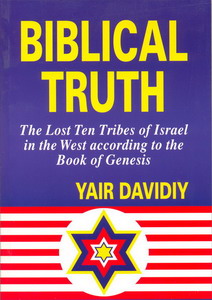|
"Shoshana Yaacov" |
|
"Shoshana Yaacov" |
|
Brit-Am Discussion Group |
Contents by Subject |
Research Revelation Reconciliation Contribute |
Site Map Contents in Alphabetical Order |
This Site |
|

|
The Lost Ten Tribes of Israel according to the Book of Genesis Biblical Prophecy Predicted that the Lost Tribes of Israel would be found amongst Western Nations. Biblical Verses analysed in the light of the Hebrew language, Rabbinical Commentary, and Historical Reality. A valuable educational, inspirational, and enjoyable work |
Extracts:
The Khazars were sometimes credited with Armenian origin: this is stated by the seventh-century Armenian bishop and historian Sebeos, and the Arab geographer Dimashqi (d. 1327). In the 13th to 14th centuries the Crimea and the area to the east were known as Gazaria (Khazaria) to western authors, and as Maritime Armenia to Armenian authors. The term Armenia often included much of Anatolia, or otherwise referred to cities on the Syrian-Mesopotamian route (now Turkey, near the Syrian frontier) such as Haran (Harran), Edessa (Urfa), and Nisibis (Na\ibin).
In the past Armenia has been connected with the biblical Ashkenaz. The Armenians are termed "the Ashkenazi nation" in their literature. According to this tradition, the genealogy in Genesis 10:3 extended to the populations west of the Volga. In Jewish usage Ashkenaz is sometimes equated with Armenia; in addition, it sometimes covers neighboring Adiabene (Targ. Jer. 51:27), and also Khazaria (David b. Abraham Alfasi, Ali ibn Suleiman; cf. S. Pinsker, Likkutei Kadmoniyyot (1860), 208; S. L. Skoss (ed.), Hebrew-Arabic Dictionary of the Bible of David ben Abraham al-Fasi (1936), 159), the Crimea and the area to the east (Isaac Abarbanel, Commentary to Gen. 10:3), the Saquliba (Saadiah Gaon, Commentary, ibid.), i.e., the territory of the Slavs and neighboring forest tribes, considered by the Arabs dependent of Khazaria, as well as Eastern and Central Europe, and northern Asia (cf. Abraham Farissol, Iggeret Orhot Olam (Venice, 1587), ch. 3). In other expositions found in rabbinical works, Armenia is linked with Uz. The anti-Jewish attitudes prevailing in eastern-Byzantine (Armenian) provinces made the Targum identify it with the "daughter of Edom that dwellest in the land of Uz" (Lam. 4:21) or with "Constantina in the land of Armenia" (now Viransehir, between Urfa and Na\ibin (Nisibis). Hence Job's "land of Uz" is referred to as Armenia in some commentaries, for instance in those of Nahmanides and Joseph b. David ibn Yahya. The "Uz-Armenia" of Abraham Farissol is however the Anatolian region near Constantinople. Armenia is also sometimes called Amalek in some sources, and Jews often referred to Armenians as Amalekites. This is the Byzantine term for the Armenians. It was adopted by the Jews from the Josippon chronicle (tenth century, ch. 64). According to Josippon, Amalek was conquered by Benjaminite noblemen under Saul (ibid., 26), and Benjaminites are already assumed to be the founders of Armenian Jewry in the time of the Judges (Judg. 19?21). Benjaminite origins are claimed by sectarian Kurds. The idea that Khazaria was originally Amalek helped to support the assumption that the Khazar Jews were descended from Simeon (I Chron. 4:42?43; Eldad ha-Dani, ed. by A. Epstein (1891), 52; cf. Hisdai ibn Shaprut, Iggeret).
Armenia is sometimes identified in literature with the biblical Minni (Pal. Targ., 51:27), based on onomatopoeic exegesis of Armenia = Har ("Mountain") Minni; similarly, Harmon (ha-Harmonah, Amos 4:3) is understood in the Targum to denote the region where the Ten Tribes lived "beyond the mountains of Armenia." Rashi identified Harmon with "the Mountains of Darkness," the term used by medieval Jews for the Caspian mountains, believed in the West to surround the kingdom of the Khazars (who were often taken for the Ten Lost Tribes) and to include the Caucasus. The reference in Lamentations Rabbah 1:14, no. 42, does not refer to the passage of the Tribes through Armenia as is usually claimed, but more probably to the Jerusalem exiles' easy (harmonyah, "harmonious") route.
Armenia has further been identified with the biblical Togarmah (Gen. 10:3). In Armenian tradition this genealogy has competed with the theory of Ashkenazi origins, and extended to the Scythians east of the Volga. The identification of Armenia as Aram (Gen. 10:22; 25:20; 28:5) is adopted by Saadiah Gaon and also occurs in Islamic literature.
| PREVIOUS ISSUES |
 |